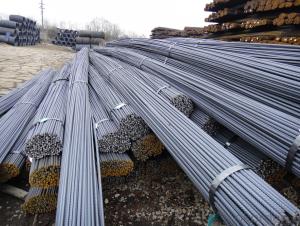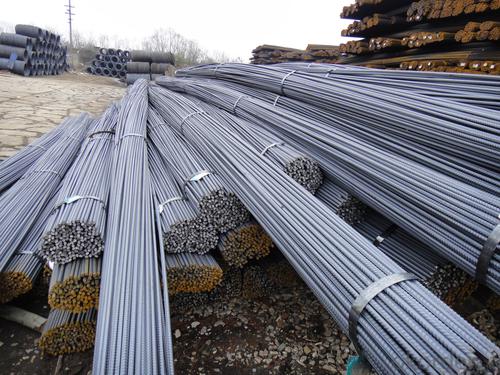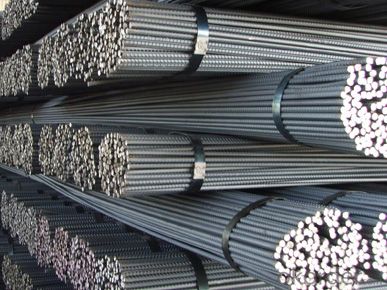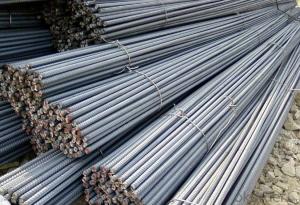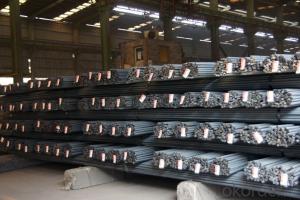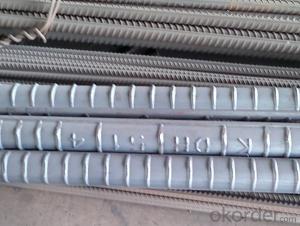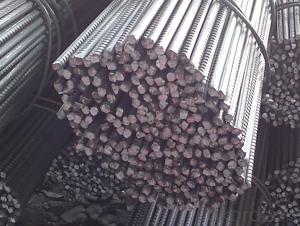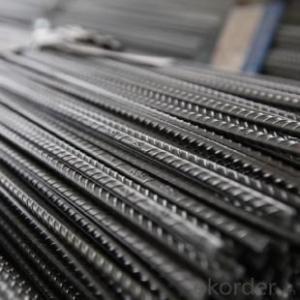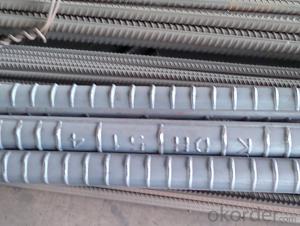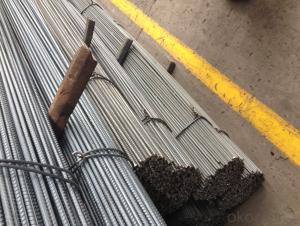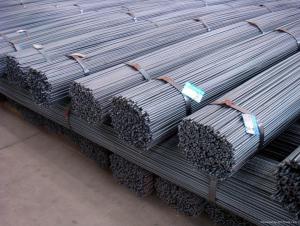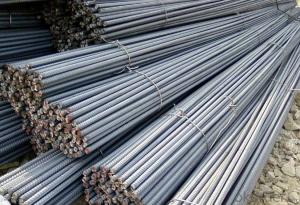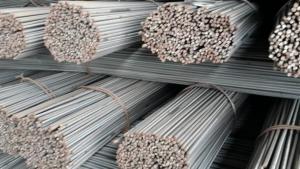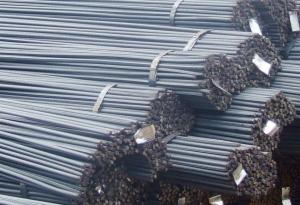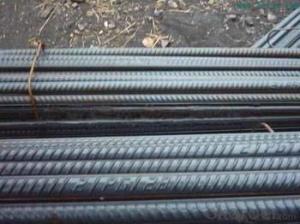High Quality Steel Deformed Bar HRB400 12/14/16mm
- Loading Port:
- Tianjin
- Payment Terms:
- TT or LC
- Min Order Qty:
- 50 m.t
- Supply Capability:
- 10000 m.t/month
OKorder Service Pledge
OKorder Financial Service
You Might Also Like
High Quality Steel Deformed Bar HRB400 12/14/16mm
Product Description:
Specifications of High Quality Steel Deformed Bar HRB400 12/14/16mm:
Standard | GB | HRB400 | |
Diameter | 12mm,14mm,16mm | ||
Length | 6M, 9M,12M or as required | ||
Place of origin | Hebei, China mainland | ||
Advantages | exact size, regular package, chemical and mechanical properties are stable. | ||
Type | Hot rolled deformed steel bar | ||
Chemical Composition of High Quality Steel Deformed Bar HRB400 12/14/16mm: (Please kindly find our chemistry of our material based on HRB400 as below for your information)
Grade | Technical data of the original chemical composition (%) | ||||||
C | Mn | Si | S | P | V | ||
HRB400 | ≤0.25 | ≤1.60 | ≤0.80 | ≤0.045 | ≤0.045 | 0.04-0.12 | |
Physical capability | |||||||
Yield Strength (N/cm²) | Tensile Strength (N/cm²) | Elongation (%) | |||||
≥400 | ≥570 | ≥14 | |||||
Theoretical weight and section area of High Quality Steel Deformed Bar HRB400 12/14/16mm as below for your information:
Diameter(mm) | Section area (mm²) | Mass(kg/m) | Weight of 12m bar(kg) |
12 | 113.1 | 0.888 | 10.656 |
14 | 153.9 | 1.21 | 14.52 |
16 | 201.1 | 1.58 | 18.96 |
Usage and Applications of High Quality Steel Deformed Bar HRB400 12/14/16mm:
Deformed bar is widely used in buildings, bridges, roads and other engineering construction. Big to highways, railways, bridges, culverts, tunnels, public facilities such as flood control, dam, small to housing construction, beam, column, wall and the foundation of the plate, deformed bar is an integral structure material. With the development of world economy and the vigorous development of infrastructure construction, real estate, the demand for deformed bar will be larger and larger.
Packaging & Delivery of High Quality Steel Deformed Bar HRB400 12/14/16mm:
Packaging Detail: products are packed in bundle and then shipped by container or bulk vessel, deformed bar is usually naked strapping delivery, when storing, please pay attention to moisture proof. The performance of rust will produce adverse effect.
Each bundle weight: 2-3MT, or as required
Payment term: TT or L/C
Delivery Detail: within 45 days after received advanced payment or LC.
Label: to be specified by customer, generally, each bundle has 1-2 labels
Trade terms: FOB, CFR, CIF
FAQ:
Q1: Why buy Materials & Equipment from OKorder.com?
A1: All products offered byOKorder.com are carefully selected from China's most reliable manufacturing enterprises. Through its ISO certifications, OKorder.com adheres to the highest standards and a commitment to supply chain safety and customer satisfaction.
Q2: How do we guarantee the quality of our products?
A2: We have established an advanced quality management system which conducts strict quality tests at every step, from raw materials to the final product. At the same time, we provide extensive follow-up service assurances as required.
Q3: How soon can we receive the product after purchase?
A3: Within three days of placing an order, we will arrange production. The shipping date is dependent upon the quatity, how many sizes you want and the plan of production, but is typically 1 month to 2 month days from the beginning of production.
Images of High Quality Steel Deformed Bar HRB400 12/14/16mm:
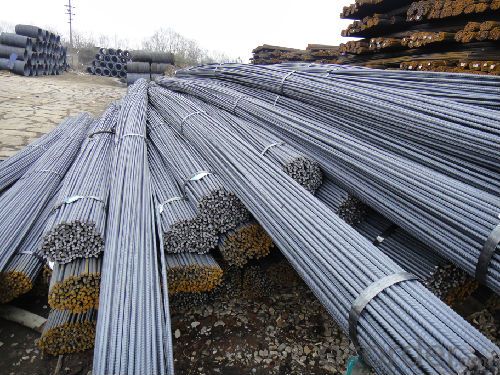
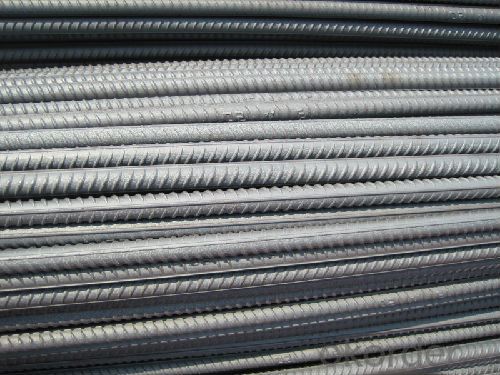
*If you would like to get our price, please inform us the size, standard/material and quantity. Thank you very much for your attention.
- Q: What is the process of inspecting steel rebars on-site?
- The quality and adherence to specifications of steel rebars on-site are ensured through a series of steps in the inspection process. Firstly, a visual inspection is conducted to identify any visible defects or damage, such as rust, cracks, bends, or improper dimensions. Immediate attention is given to any issues found. Next, accurate measurements are taken using tools like calipers or measuring tapes. The length, diameter, and shape of each rebar are compared against the project specifications to ensure they meet the required dimensions. For certain projects, chemical analysis of the steel rebars may be necessary to confirm their composition and strength. Samples are taken from different batches and sent to a lab for testing, with the results determining compliance with standards. Non-Destructive Testing (NDT) techniques are utilized to evaluate the internal integrity of the rebars without causing damage. Ultrasonic testing, magnetic particle inspection, and radiography are employed to detect hidden defects like cracks, voids, or inclusions. If welding is involved, the inspector checks the welds for proper penetration, alignment, and quality. This guarantees the strength and integrity of the joint. Throughout the inspection process, detailed records are maintained. These records include information about the inspections conducted, measurements taken, test results, and identified defects. They serve as evidence of compliance and can be referred to in case of disputes or future reference. Once the inspection is complete, a detailed report is prepared summarizing the findings. This report is shared with the project management team, engineers, and other relevant stakeholders. It highlights any non-compliance, defects, or areas that require attention. In conclusion, the on-site inspection of steel rebars is a comprehensive and systematic approach that ensures their quality, integrity, and compliance with project specifications and industry standards.
- Q: What is the resistance of steel rebars against acid attacks?
- Steel rebars have a high resistance against acid attacks due to their inherent corrosion-resistant properties. The steel's protective oxide layer helps prevent the acid from penetrating and causing significant damage to the rebars. However, prolonged exposure to highly concentrated or aggressive acids may eventually lead to corrosion, necessitating appropriate protective measures.
- Q: How are steel rebars transported and stored on construction sites?
- Steel rebars are typically transported to construction sites using trucks or trailers. Once they arrive, rebars are unloaded and stored in an organized manner to ensure easy access and prevent damage. They are commonly stacked horizontally on racks or placed vertically in bundles, secured with wire or straps. Additionally, rebars should be stored on a clean, dry surface to avoid rusting and corrosion.
- Q: Do steel rebars have any specific markings or codes?
- Yes, steel rebars typically have specific markings or codes to indicate their size, type, and grade. These markings are essential for identifying and ensuring the correct usage of rebars in construction projects.
- Q: What are the different methods for attaching steel rebars to existing structures?
- There are several methods for attaching steel rebars to existing structures, depending on the specific requirements and conditions of the project. Some common methods include: 1. Welding: This method involves using welding techniques to attach the rebars to the existing structure. It provides a strong and durable connection, but it requires skilled labor and may not be suitable for all situations. 2. Epoxy bonding: Epoxy adhesives can be used to bond rebars to existing structures. This method is easy to apply and provides a reliable connection, especially when the rebars are embedded in concrete. However, it is important to ensure proper surface preparation and follow manufacturer's instructions for best results. 3. Mechanical anchoring: Mechanical anchors, such as anchor bolts or expansion anchors, can be used to attach rebars to existing structures. This method involves drilling holes into the structure and inserting the anchor, which provides a secure connection. It is important to select the appropriate anchor type and size based on the load requirements and structural conditions. 4. Clamping or fastening: In some cases, rebars can be attached to existing structures using clamps or fasteners. This method is relatively quick and easy to install, but it may not provide as strong of a connection as welding or epoxy bonding. 5. Overlapping: When reinforcing existing concrete structures, rebars can be overlapped with the existing reinforcement and tied together using wire or other methods. This method is commonly used in construction to ensure continuity of reinforcement and increase the load-carrying capacity. It is important to consult with structural engineers or professionals with expertise in rebar installation to determine the most suitable method for attaching steel rebars to existing structures. They will consider factors such as structural integrity, load requirements, and local building codes to ensure a safe and effective connection.
- Q: What are the guidelines for the proper curing of concrete with steel rebars?
- The guidelines for the proper curing of concrete with steel rebars include ensuring a moist and controlled environment for the concrete to cure. This can be achieved by covering the concrete with a plastic sheet or using curing compounds. It is important to avoid rapid drying or exposure to extreme temperatures during the curing process. Additionally, regular monitoring of the curing process and proper hydration of the concrete are crucial to ensure the rebars bond effectively with the concrete and achieve maximum strength.
- Q: How do steel rebars affect the overall construction cost of industrial buildings?
- Steel rebars can significantly affect the overall construction cost of industrial buildings due to their crucial role in enhancing structural strength and durability. While the initial cost of steel rebars might be higher compared to other materials, their use can reduce the need for additional structural support, leading to potential cost savings in terms of labor, time, and materials. Moreover, steel rebars offer long-term benefits by minimizing maintenance and repair expenses, ultimately contributing to the overall cost-effectiveness of the construction project.
- Q: Are steel rebars susceptible to magnetic fields?
- Yes, steel rebars are susceptible to magnetic fields as they are made primarily of iron, which is a ferromagnetic material.
- Q: Can steel rebars be used in railway and transportation infrastructure?
- Yes, steel rebars can be used in railway and transportation infrastructure projects. Steel rebars are commonly used in the construction of bridges, tunnels, and other transportation-related structures due to their high strength, durability, and ability to withstand heavy loads. They provide structural reinforcement and enhance the overall stability and longevity of railway and transportation infrastructure.
- Q: What are the different methods of cutting and bending steel rebars on-site?
- There are several methods commonly used to cut and bend steel rebars on-site. These include using manual tools such as rebar cutters and bending bars, as well as power tools like rebar saws and electric rebar benders. Each method has its advantages and limitations, and the choice depends on the specific requirements of the project and the available resources.
Send your message to us
High Quality Steel Deformed Bar HRB400 12/14/16mm
- Loading Port:
- Tianjin
- Payment Terms:
- TT or LC
- Min Order Qty:
- 50 m.t
- Supply Capability:
- 10000 m.t/month
OKorder Service Pledge
OKorder Financial Service
Similar products
Hot products
Hot Searches
Related keywords
